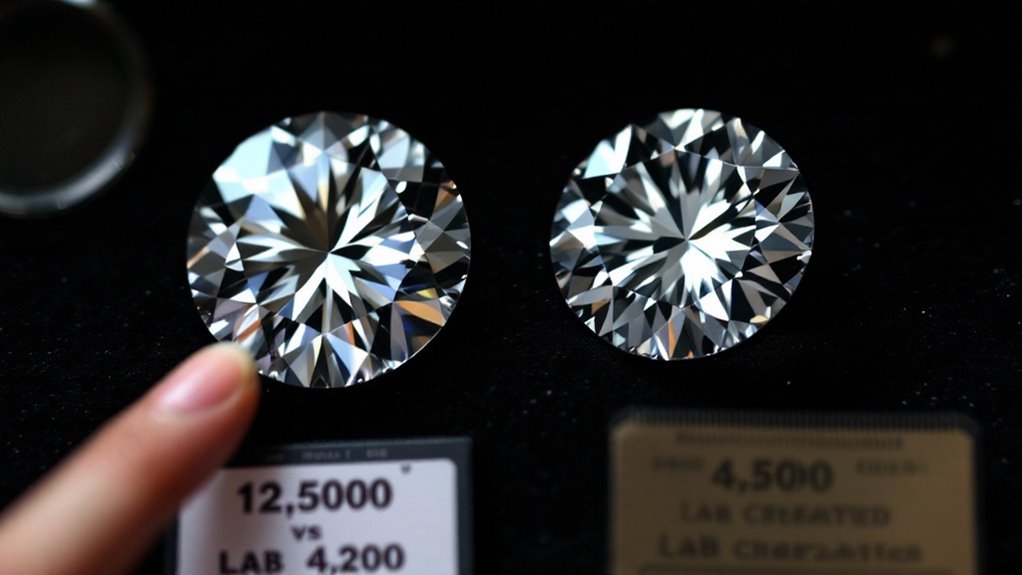Jewelers rely on sophisticated equipment like DiamondView™ systems and FTIR spectrometers to spot the telltale differences between natural and lab-created diamonds. While they're chemically identical, each type reveals unique growth patterns under analysis – natural stones show subtle, curved lines formed over billions of years, while lab diamonds display arrow-straight patterns and metallic traces. You'll discover that even microscopic inclusions tell a fascinating story of each stone's origin.
Understanding Diamond Formation: Natural Vs Laboratory Process

While diamonds have captivated humanity's imagination for millennia, you'd be amazed at how differently they form in nature versus the lab.
In Earth's depths, carbon atoms endure crushing pressures and searing temperatures for billions of years, crystallizing into nature's most brilliant gems. It's a process that'll make you feel microscopic in comparison to Earth's patient craftsmanship.
In contrast, lab-created diamonds emerge from high-pressure, high-temperature chambers that fundamentally compress time itself.
You're witnessing humanity's audacious attempt to replicate nature's masterpiece in mere weeks. These chambers, reaching temperatures that'd vaporize steel, force carbon atoms to dance to science's tune rather than Earth's rhythm.
While both processes yield chemically identical stones, there's something almost unsettling about how we've learned to fast-forward geologic time.
Advanced Testing Equipment and Tools
Modern diamond testing equipment reads like something out of a sci-fi novel, yet it's sitting right there in gemologists' labs today.
You'll find yourself holding your breath as these incredible machines peer into the very soul of each stone, revealing its deepest secrets.
Here's what you'll typically encounter in a high-end gemological laboratory:
- DiamondView™ fluorescence imaging systems that expose growth patterns you couldn't imagine existed
- FTIR spectrometers that analyze a diamond's molecular composition with terrifying precision
- X-ray fluorescence machines that map trace elements like a diamond detective
- Automated proportion analyzers that measure every angle with microscopic accuracy
- Multi-spectrum light sources that make inclusions glow like tiny alien worlds
Your heart might skip a beat when you realize how these tools can strip away any uncertainty about a diamond's origin.
Growth Pattern Analysis and Crystal Structure

Even trained gemologists can find themselves second-guessing their assessments until they've studied a diamond's growth patterns – those telltale signatures etched into every crystal.
You'll notice that natural diamonds form over millions of years, creating distinctive octahedral crystal structures with subtle growth lines that meander like ancient riverways.
Lab-created diamonds, while chemically identical, tell a different story. They've grown in a matter of weeks, leaving behind telltale metallic inclusions and arrow-straight growth patterns that betray their hasty birth.
When you're peering through a microscope at these crystalline fingerprints, your heart might skip a beat as you spot the cubic growth sectors – dead giveaways of synthetic origin that no amount of technological advancement can fully disguise.
Identifying Trace Elements and Inclusions
Inside every diamond lies a microscopic world of chemical signatures and tiny imperfections that'll make your palms sweat as you search for the truth.
Within each glittering stone, a hidden universe of molecular secrets awaits discovery, challenging experts to unveil its mysterious origins.
You'll need a trained eye and sophisticated equipment to spot these telltale differences between natural and lab-created stones.
- Natural diamonds often contain nitrogen impurities that create a faint yellow tinge
- Lab diamonds typically show traces of metallic catalysts like nickel or iron
- Microscopic cloud-like formations appear exclusively in natural stones
- Growth sectors in lab diamonds form distinctive geometric patterns
- Natural stones display random crystal inclusions that formed over millions of years
When you're peering through that loupe, heart racing, you'll notice these microscopic fingerprints telling their ancient tales.
The pressure's on as you scrutinize each crystal face, knowing that one tiny detail could reveal whether nature or science crafted this sparkling enigma.
UV Fluorescence Detection Methods

Beyond the microscopic domain of inclusions, ultraviolet light pierces through a diamond's crystalline facade to expose its deepest secrets.
You'll notice how natural diamonds often emit a soft blue glow under UV light, while their lab-created counterparts might betray themselves with an eerie phosphorescence that's just a bit too perfect.
When you're examining these stones under UV, there's always that heart-stopping moment when the truth reveals itself.
Some lab diamonds don't fluoresce at all – they're eerily dark, like a black hole absorbing light.
Others might give off unusual colors – greens or oranges that you'd never see in nature.
The DiamondView™ imaging system, which uses short-wave UV, is particularly unforgiving.
It'll expose those telltale growth patterns that synthetic stones can't hide, no matter how flawless they appear to the naked eye.
Spectroscopy and Chemical Composition Tests
While the naked eye and UV tests can leave you guessing, spectroscopy rips away all pretense by laying bare a diamond's atomic architecture.
You'll feel your heart race as the machine hums to life, knowing it's about to expose your stone's deepest secrets. The process is ruthlessly precise, using high-energy beams that make diamonds sing their atomic song.
- Infrared spectroscopy reveals growth patterns unique to lab creation
- Photoluminescence exposes tell-tale nitrogen clusters
- X-ray diffraction maps crystal structure variations
- Mass spectrometry identifies trace elements
- FTIR analysis detects synthetic growing media residues
When you're staring at those jagged peaks on the spectrometer's display, there's no hiding the truth.
Lab-grown diamonds contain subtle chemical signatures that betray their artificial origins, and these tests will catch them every time.
Price Comparison and Market Value

The raw economics of diamond pricing can make your palms sweat and your stomach churn.
You'll find that lab-created diamonds typically cost 40-60% less than their natural counterparts, and there's a reason your jeweler might shift uncomfortably when you ask about this price gap.
While both types share identical chemical properties, you're really paying for rarity and tradition with natural stones.
Here's the gut-wrenching reality: that gorgeous lab-created diamond you've just purchased for $5,000 won't hold its value like a mined stone.
Natural diamonds, despite their inflated retail markups, maintain better resale value because they're still perceived as "real."
It's a bitter pill to swallow, but the market's perception – not the stone's actual quality – drives this frustrating value proposition.
Certification and Authentication Process
Since you don't want to gamble with thousands of dollars on a fake stone, you'll need to understand the nerve-wracking world of diamond certification. Your hands might tremble as you await verification from renowned labs like GIA or IGI, who'll scrutinize every facet of your precious gem.
Here's what they're looking for:
- Distinctive growth patterns visible under specialized microscopes
- Trace elements and crystal structure using spectroscopic analysis
- Fluorescence response to ultraviolet light exposure
- Phosphorescence patterns after UV exposure ends
- Minute inclusions that tell the stone's formation story
While you're biting your nails waiting for results, these labs are using cutting-edge technology worth millions to authenticate your diamond.
They'll issue a detailed report that's fundamentally your stone's DNA profile, complete with plots, grades, and measurements that'll prove its origin beyond doubt.
Ethical Considerations and Environmental Impact

Beyond those scientific certifications and lab reports lies a minefield of moral questions that'll keep you up at night.
You'll find yourself tossing and turning, weighing the environmental devastation of traditional diamond mining against the energy-intensive processes of lab creation. Traditional mining's left gaping wounds in Earth's surface, while displacing indigenous communities and funding conflicts you'd rather not think about.
But here's the twist – those pristine lab diamonds aren't exactly carbon-neutral angels either. They're gobbling up massive amounts of electricity, often from fossil fuel sources, to recreate nature's million-year process in just a few weeks.
You're caught between the devil you know and the one you don't, each option leaving its own distinctive scar on our planet's conscience.
Conclusion
Isn't it fascinating how far technology has come in creating diamonds that are nearly identical to natural ones? While you'll need sophisticated equipment and expertise to tell them apart, you can rest assured that certified jewelers have the tools and knowledge to identify their origin. Whether you choose lab-created or natural diamonds, you're getting a genuine stone – the main difference lies in its birth story and environmental footprint.



